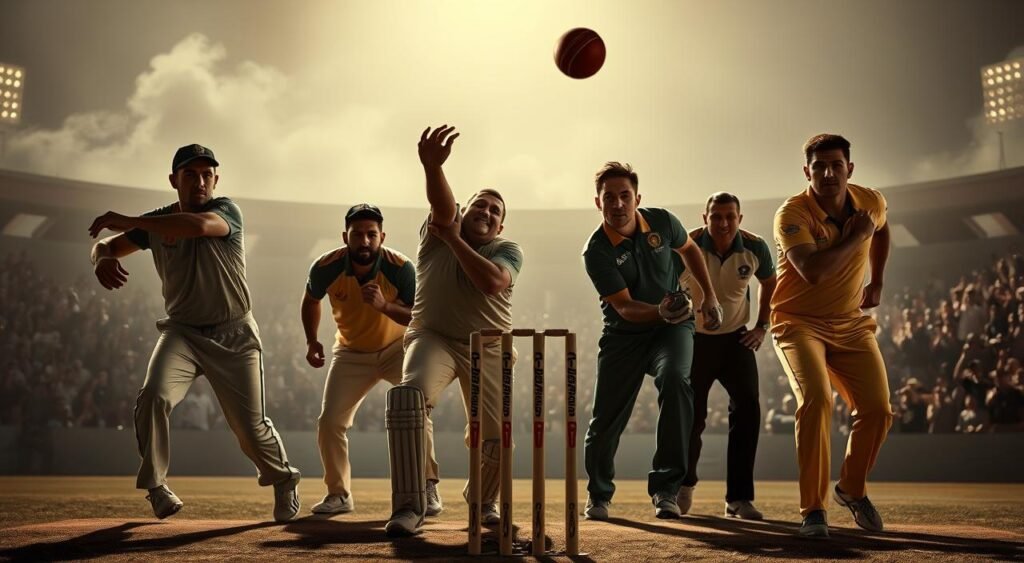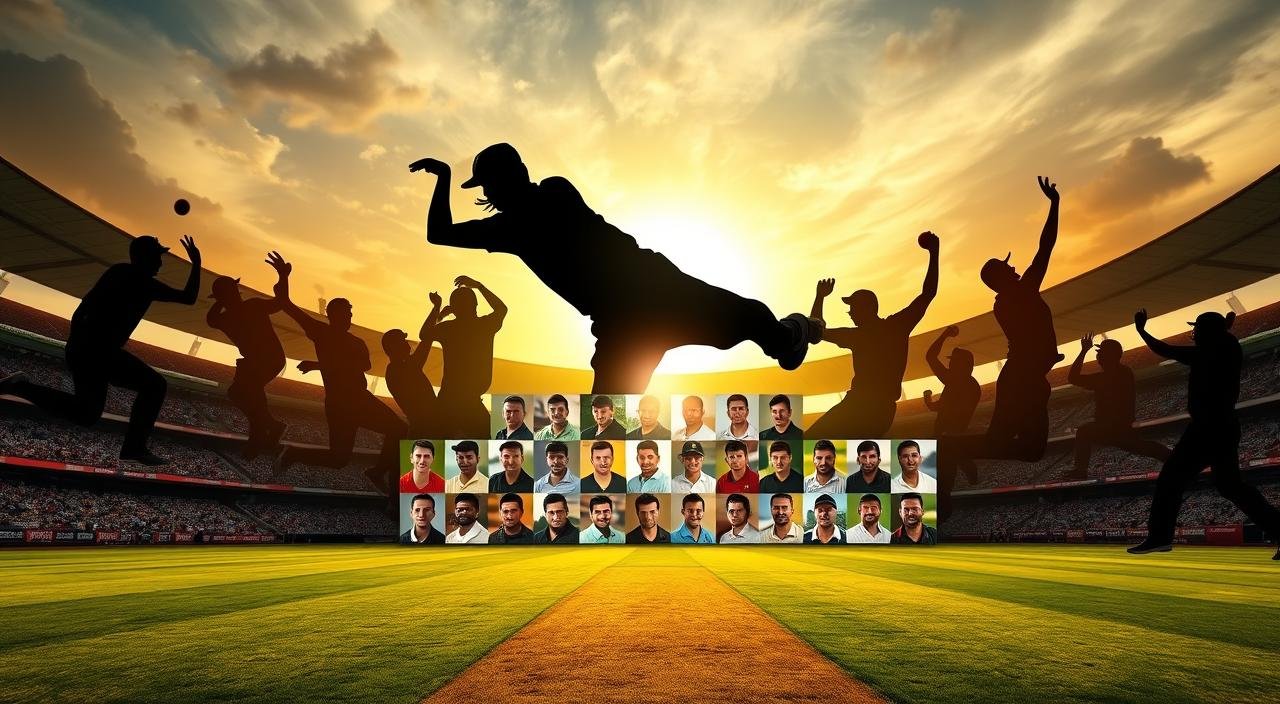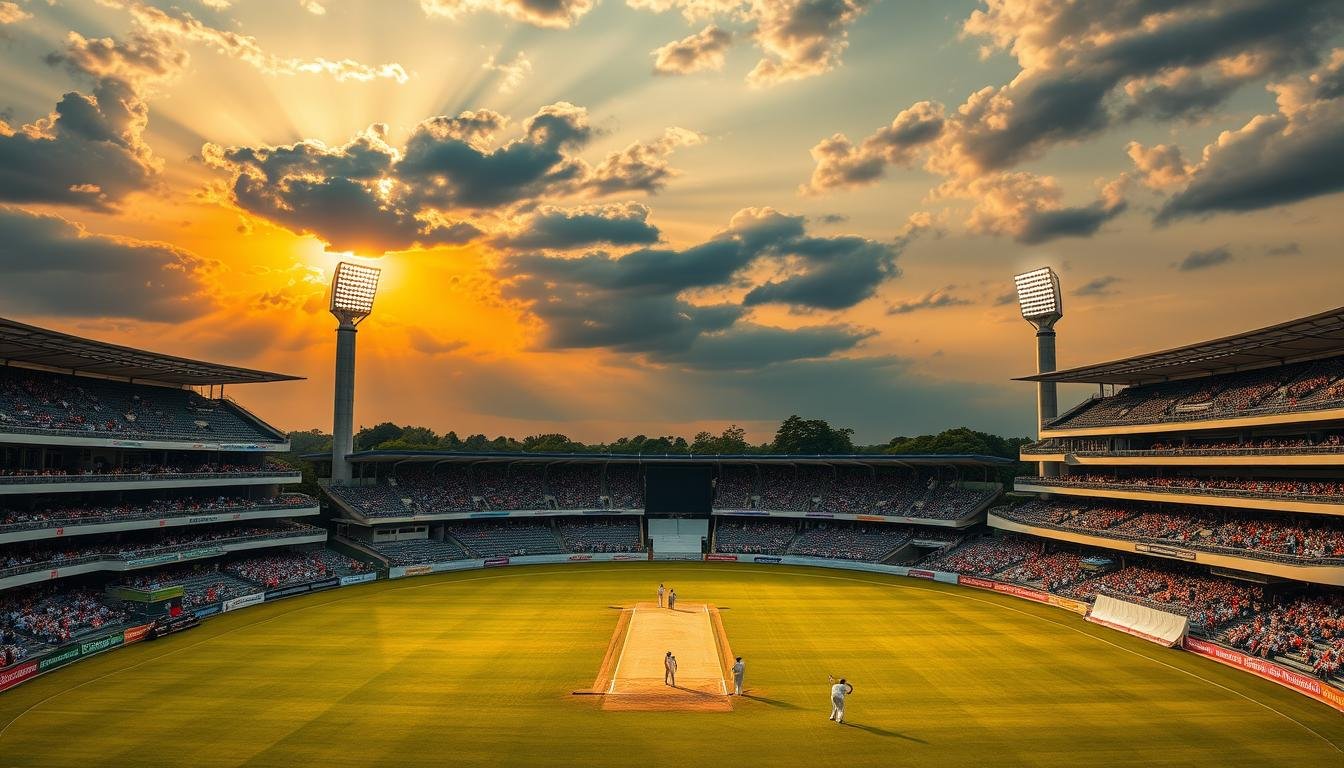Cricket has long celebrated bowlers based on their sheer wicket count, but does that truly reflect greatness? The debate has persisted for decades, highlighting the need for a more comprehensive analysis.
Conventional evaluations have several limitations. Many legendary bowlers played significantly fewer matches due to their era or team schedules, while others were deprived of favorable conditions that could have boosted their numbers.
A more nuanced approach is required to identify the greatest odi bowlers of all time. This article will explore the evolution of ODI cricket and analyze the impact of bowlers beyond just wicket tallies.
Key Takeaways
- A comprehensive analysis of ODI bowlers considering multiple performance metrics.
- Examination of how rule changes and playing conditions have impacted bowling statistics.
- Detailed profiles of the 30 greatest ODI bowlers, highlighting their career achievements.
- Analysis of the unique skills and techniques that define greatness in ODI bowling.
- Discussion of current active bowlers who might join the list of all-time greats.
The Evolution of ODI Bowling
The evolution of ODI bowling is a story of adaptation, influenced by changing rules, pitches, and the competitive landscape. Over the years, the game has seen significant transformations that have impacted bowling strategies and statistics.
How ODI Cricket Has Changed Over the Decades
ODI cricket has undergone substantial changes, affecting how bowlers perform. The introduction of two new balls in 25 overs since 2010 has been a significant rule change. Additionally, powerplay rules have evolved, from having two fielders outside the circle in the first 15 overs to the current system where the first ten overs are powerplay overs, followed by specific restrictions in the subsequent overs.
- The shift from one new ball to two has reduced the effectiveness of reverse swing specialists.
- Field restrictions and powerplays have consistently favored batsmen, impacting bowling averages.
The Impact of Rule Changes on Bowling Statistics
Rule changes have dramatically altered the statistical landscape for ODI bowlers. The evolution of the no-ball rule to include free hits has added pressure on bowlers, affecting their economy rates. Restrictions on bouncers, wider pitches, and smaller boundaries have made bowling more challenging.
- Pre-2000 statistics generally show better bowling averages compared to post-2010 figures.
- The rating of bowlers must consider these contextual factors to properly evaluate performances across different eras.
Understanding these changes is crucial for assessing the impact of bowlers across different periods and conditions. The game has become increasingly challenging for bowlers, as teams adapt their strategies to the evolving rules and conditions.
Methodology: How We Ranked the Greatest ODI Bowlers
The process of ranking the greatest ODI bowlers involved creating a multifaceted evaluation framework that assesses bowlers based on their overall impact on the game. To achieve this, we developed a comprehensive methodology that incorporates various key performance metrics.
Key Performance Metrics Considered
When evaluating the greatest ODI bowlers, we considered several key metrics, including the number of wickets taken, performance against top teams, and performance in various conditions. These metrics provide a well-rounded view of a bowler’s ability to perform under various circumstances and against different teams.
The Combined Bowling Rate (CBR) Formula
The Combined Bowling Rate (CBR) is a measure that integrates three fundamental bowling metrics: bowling average, strike rate, and economy rate. The CBR formula uses a harmonic mean calculation: CBR = 3 / (1/Average + 1/Strike Rate + 1/Economy Rate). This approach provides a balanced assessment that prevents any single metric from dominating the rating. A lower CBR indicates superior bowling performance.
| Metric | Description | Weightage |
|---|---|---|
| Bowling Average | Effectiveness at taking wickets | Equal |
| Strike Rate | Frequency of wicket-taking | Equal |
| Economy Rate | Run restriction ability | Equal |
We enhanced the basic CBR with contextual multipliers to improve performance against top teams (1.5x), in away conditions (1.25x), and in tournament or knockout matches (1.3x). An “Impact Factor” was also incorporated to measure performance in high-pressure situations and match-winning contributions.
The Impact of Playing Conditions on Bowling Greatness
The ability of bowlers to adapt to different conditions is crucial in determining their greatness. The conditions under which bowlers perform can significantly affect their statistics and overall rating.
Home vs. Away Performance
The distinction between home and away performances is a critical aspect of evaluating a bowler’s greatness. Bowlers who excel in both home and away conditions demonstrate a higher level of skill and adaptability. For instance, Wasim Akram and Waqar Younis were renowned for their ability to perform under various conditions, including away from home.
Performance in Different Conditions
Different conditions, such as seam, swing, bounce, and spin pitches, require bowlers to adjust their strategies. Pace bowlers often struggle in Asian conditions, where pitches are typically slower and lower, while spinners face challenges on bouncy, pace-friendly pitches. The greatest bowlers, such as Muttiah Muralitharan and Glenn McGrath, have demonstrated the ability to succeed across various conditions, making them stand out among their peers.
To evaluate a bowler’s performance in different conditions, we considered factors such as the number of innings played in favorable and unfavorable conditions. For example, non-Asian bowlers needed to have played at least 20 innings against non-weak teams outside Asia to be considered for the favorable conditions rating.
The Top 10 Greatest ODI Bowlers of All Time
The world of cricket has witnessed numerous exceptional bowlers, and we’re about to explore the top 10 ODI bowlers of all time. These cricketing legends have left an indelible mark on the game with their extraordinary skills and achievements.
The Elite Five
The top 5 greatest ODI bowlers are a mix of pace and spin, with some having made their mark in the history of the game. Wasim Akram and Waqar Younis are often credited with revolutionizing pace bowling, particularly in the art of swing bowling. Their ability to swing the ball both ways, including the challenging reverse swing, sets them apart.
The top-ranked bowlers have demonstrated exceptional skill, with some achieving remarkable milestones. For instance, bowlers like Wasim Akram have been instrumental in defining the art of swing bowling. Their statistics and impact on the game are a testament to their greatness.
The Legendary Contenders
Let’s dive into the bowlers who make up the 6th to 10th positions. N Kapil Dev ranks sixth with a rating of 55.32. His all-round abilities complemented his bowling prowess, with 253 wickets at an economy rate of 3.72. Kapil Dev’s ability to swing the ball in all conditions makes him India’s greatest one-day international (ODI) bowler.
- Allan Donald takes seventh place, known for his extreme pace and hostility, claiming 272 wickets at an average of 21.79.
- Rashid Khan places eighth, his exceptional average, economy, and strike rate already establishing him among the all-time greats.
- Courtney Walsh secures ninth position with his high-arm action and metronomic consistency, yielding 227 wickets.
- Craig McDermott completes the top ten, excelling particularly in World Cup competitions with 203 wickets.
These bowlers have shown diverse paths to greatness, from all-round excellence to raw pace and mystery spin.
Their achievements underscore the impact of bowling on the game, with conditions and teams playing a significant role in their success. The rating system used to rank these bowlers considers various metrics, including the number of wickets taken and their overall impact on the game.
Positions 11-20: Exceptional Bowling Talents
ODI cricket’s rich history is replete with bowlers who have left an indelible mark, and the 11th to 20th positions are a testament to this legacy. These bowlers have showcased a range of skills that have been pivotal in shaping the outcome of numerous matches.
Masters of Their Craft
The bowlers ranked 11th to 15th have demonstrated mastery over their craft, each with unique strengths that have contributed significantly to their teams’ successes.
- Daniel Vettori (16th) exemplified the modern left-arm spinner’s art, taking 305 wickets at an exceptional economy rate of 4.12 across 295 matches.
- Abdul Razzaq (17th) combined his all-round capabilities with clever medium-pace bowling, claiming 269 wickets with subtle variations.
- Makhaya Ntini (18th) had a special bowling style and great energy. He took 266 wickets and challenged even the best batsmen with his unusual angle. Makhaya Ntini (18th) brought a unique bowling action and relentless energy, taking 266 wickets and troubling even the best batsmen with his awkward angle.
- Darren Gough (19th) established himself as England’s premier ODI bowler with 235 wickets, his reverse swing and yorkers making him effective in the death overs.
- Anil Kumble (20th) adapted his Test match precision to the ODI format, taking 337 wickets with subtle variations in pace and bounce.
Game-Changing Performers
The bowlers from the 16th to the 20th have been game-changers, bringing unique qualities to their teams and often delivering in match-defining moments.
- Vettori’s economy and control were crucial in limiting opposition scores.
- Razzaq’s versatility allowed him to break partnerships at critical moments.
- Ntini’s unorthodox angle and energy troubled batsmen, making him a valuable asset.
- Gough’s expertise in the death overs with his reverse swing and yorkers was pivotal.
- Kumble’s precision and subtle variations made him a formidable opponent.
Wasim Akram’s influence is evident in several of these bowlers, with his technical innovations providing a template for many who followed. Their contributions often came in crucial moments, particularly against quality opposition, showcasing their ability to perform under pressure.
Positions 21-30: Remarkable ODI Bowling Careers
Rounding out our top 30, bowlers 21-30 showcased incredible talent and perseverance in the competitive world of ODI cricket. These bowlers often operated in challenging conditions and against strong teams, yet they consistently made a significant impact on the game.

21-25: Consistent Performers
The bowlers ranked 21-25 are notable for their consistency and ability to perform under pressure. They took crucial wickets and played a vital role in their teams’ successes. Their bowling skills were honed through dedication and hard work, allowing them to compete at the highest level.
These consistent performers often found themselves in harsh conditions, but their skill and adaptability allowed them to excel. They were key players in their respective teams, contributing significantly to their team’s overall performance rating.
26-30: Underrated Bowling Legends
The bowlers ranked 26-30 are often seen as underrated legends. This group includes Nuwan Kulasekara, Mitchell Starc, Ajit Agarkar, Nathan Bracken, and Andy Caddick. The bowlers ranked 26-30, including Nuwan Kulasekara, Mitchell Starc, Ajit Agarkar, Nathan Bracken, and Andy Caddick, are often considered underrated legends. Kulasekara exemplified the art of swing bowling with a modest pace, taking 199 wickets at an average of 33.92. Starc has established himself as a premier left-arm fast bowler, with 238 wickets at 22.62.
- Nuwan Kulasekara (26th) took 199 wickets at 33.92, showcasing his skill in swing bowling.
- Mitchell Starc (27th) has 238 wickets at 22.62, known for his tournament performances and ability to produce unplayable yorkers.
- Ajit Agarkar (28th) overcame his slight frame to take 288 wickets at 27.85, his deceptive pace and swing making him one of India’s most prolific ODI wicket-takers.
- Nathan Bracken (29th) refined the art of left-arm seam bowling, taking 174 wickets at 24.36 with an exceptional economy rate of 4.41.
- Andy Caddick (30th) utilized his height and bounce to claim 234 wickets at 29.91, his awkward action and consistent line making him effective across all conditions.
These bowlers often operated in the shadow of more celebrated contemporaries, but they delivered performances that statistically matched or exceeded many higher-ranked players. Their contributions frequently came in supporting roles, providing balance to their teams’ attacks and allowing more aggressive bowlers to operate from the other end.
Specialist Skills That Defined the Greatest ODI Bowlers
In the world of ODI cricket, bowlers with specialized skills have made a significant impact. The ability to adapt and innovate has been crucial for bowlers to succeed in this format.
The Art of Swing Bowling
The art of swing bowling has been a defining characteristic of many great one-day international (ODI) bowlers. Wasim Akram and Waqar Younis are legendary for their ability to swing the ball both ways, making them nearly unplayable at times. The skill involves not only the natural swing of the ball but also the ability to reverse swing, which has been a game-changer in One-Day International (ODI) cricket.
The impact of swing bowling is significant, as it creates uncertainty for batsmen, making it difficult for them to anticipate the ball’s trajectory.
Spin Wizardry in Limited Overs Cricket
Spin bowling in ODI cricket has undergone significant evolution, with bowlers like Muttiah Muralitharan and Rashid Khan redefining the role of spinners in the limited-overs format. Muralitharan’s unique wrist action and ability to turn the ball sharply set a new benchmark. Rashid Khan represents the modern evolution of wrist spin, combining high pace with sharp turn and disguised variations.
The greatest ODI spinners have demonstrated exceptional adaptability, adjusting their approach according to conditions, opposition, and the match situation. This adaptability has made them invaluable to their teams and a key factor in their success.
Tournament Impact: World Cup and Champions Trophy Performances
In the high-pressure environment of the World Cup and Champions Trophy, the world’s top ODI bowlers have delivered their most memorable performances. These tournaments have historically been the stage for bowlers to showcase their talent and make a lasting impact on the game.
Bowlers Who Dominated ICC Events
The greatest ODI bowlers are often defined by their ability to deliver in knockout matches. Ravindra Jadeja tops the list with a Win Impact of 119.32, followed closely by Glenn McGrath with 118.50. Other notable bowlers include Mitchell Johnson and Brett Lee, who have consistently performed under pressure in major ICC events.

Clutch Performances in Knockout Matches
Some of the most iconic performances in cricket history have come from bowlers in the World Cup and the Champions Trophy. Wasim Akram’s two wickets in two balls in the 1992 World Cup final changed the course of the match, securing Pakistan’s only World Cup title to date. Similarly, Glenn McGrath’s 3/18 in the 2007 World Cup final dismantled Sri Lanka’s top order, securing Australia’s third consecutive title. These clutch performances tend to remain in cricket’s collective memory longer than statistical achievements, creating lasting legacies that define careers.
As Joel Garner once said, “The ability to perform under pressure is what separates the greats from the good.” This is evident in the performances of bowlers like Anil Kumble, who took 6/12 against West Indies in the 1993 Hero Cup final, and Mohammad Amir, who delivered a match-winning opening burst against India in the 2017 Champions Trophy final.
Current Active Bowlers Who Could Join the List
The world of ODI cricket is witnessing a new generation of bowlers who could potentially join the ranks of the all-time greats. With their impressive skills and consistent performances, these bowlers are making a significant impact in the cricketing world.
Rising Stars of ODI Bowling
Bowlers like Kagiso Rabada and Mustafizur Rahman are standout performers in the modern era of One-Day International (ODI) cricket. At just 28, Rabada has already secured 157 wickets, and with continued consistency, he could reach 400 wickets in the next 7-8 years. Similarly, Mustafizur Rahman, with 163 wickets at the same age, has the potential to surpass 350 wickets if he regains his form.
- Rabada’s ability to take crucial wickets has been a game-changer for his team.
- Mustafizur’s unique bowling style has made him a challenging opponent for batsmen worldwide.
What It Takes to Join the All-Time Greats
To be considered among the greatest ODI bowlers, a combination of statistical excellence, longevity, adaptability, and impact is essential. Key statistical benchmarks include a minimum of 250-300 One-Day International (ODI) wickets, a bowling average under 25, an economy rate of less than 4.50, and a strike rate of better than 35.
- Longevity in the modern era is challenging due to the three-format structure of international cricket.
- Adaptability across different conditions, from bouncy Australian tracks to subcontinental spinning pitches, is crucial.
- Impact in crucial matches, especially in World Cups and Champions Trophy events, significantly elevates a bowler’s standing.
As the game continues to evolve, the next generation of bowlers will need to demonstrate exceptional skill, innovation, and consistency against top opposition to join the ranks of the all-time greats.
Conclusion: The Legacy of the Greatest ODI Bowlers
The impact of the greatest ODI bowlers extends far beyond their statistical achievements. Muttiah Muralitharan, Wasim Akram, Waqar Younis, Chaminda Vaas, and Shahid Afridi are icons who have redefined the game with their unmatched skill and inventiveness.
These bowling legends have not only dominated matches but have also shaped the fundamentals of one-day international (ODI) cricket. Their influence has been felt worldwide, inspiring aspiring cricketers and motivating teams to strive for excellence. The evolution of ODI bowling techniques, from conventional swing to reverse swing and modern variations, has been driven by these innovative greats.
The geographical diversity of these bowling legends demonstrates that excellence in bowling transcends conditions and cultures. As ODI cricket continues to evolve, these legendary bowlers set a benchmark for greatness, reminding us that bowling skill, intelligence, and adaptability remain central to cricket’s appeal and competitive balance.
Their legacy will continue to be celebrated as the game adapts to new formats and challenges. The greatest ODI bowlers have left an indelible mark on cricket, and their impact will be felt for generations to come.




